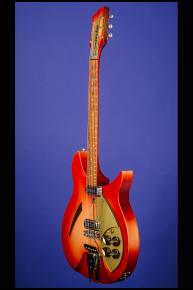"The Quintessential Rickenbacker"
A Fine and all Original 1960 335 Capri with the Rickenbacker 'Doc Kauffman' Vibrato tailpiece
1960 Rickenbacker 335 Capri O.S. (two pickups, with vibrato)
This 15-inch-wide, thicker-body (just over 2 inches deep) full-size 335 Capri is one of just thirteen Fireglo examples with the two inch plus thick body and the Doc Kauffman vibrato produced only in 1960. The guitar weighs just 7.40 lbs. and features a hollow maple body with a one-piece maple top and a one-piece maple back. Single large unbound 'slash' sound hole. Three-piece 'flamey' maple/walnut/maple neck with a nut width of just under 1 11/16 inches, a scale length of 25.00 inches and a wonderful medium-to-thick profile. Brazilian rosewood fretboard with twenty-one original medium-thin frets and inlaid white dot position markers. Headstock with gold opaque plastic logo plate with black lettering secured by three slot-head screws. Double truss rod. Individual 'single-line' Kluson Deluxe tuners with oval metal buttons (all stamped "D-169400 / Patent No." on the underside) and hexagonal bushings. Two Rickenbacker chrome bar "toaster" pickups with chrome covers and outputs of 7.90k and 7.62k. Two-piece gold lucite pickguard with four screws. Five controls (two volume, two tone, and a 'blend' control) plus three-way pickup selector switch, all on pickguard. Rickenbacker TV style brown plastic knobs with gold diamond inlays on top. The potentiometers are stamped "137 6006" (CTS February 1960). Height-adjustable Rickenbacker bridge with six individually adjustable metal saddles and Rickenbacker 'Doc Kauffman' Vibrato tailpiece. The serial number "2V 029" is stamped onto the jack plate. Inside the control cavity is written in pencil "Brown". There is a small amount of playing wear on the bass side of the neck by the first three frets and a few really miniscule surface marks on the body. This guitar has been played but absolutely 'babied' by the previous owner. The original frets have been professional dressed and the guitar plays like a dream. This beautiful piece of Rickenbacker history is in exceptionally fine (9.00+) condition. Complete with the original Rickenbacker polishing cloth and an original box of Rickenbacker "A" strings in their original printed envelopes. Housed in its original Rickenbacker three-latch, rectangular silver hardshell case with black leather ends and red plush lining (9.00).
"The letter in the serial number on hollow bodies, either a V or a T, indicated the tail-piece style. V stood for vibrato model and T stood for tailpiece (non-vibrato) model… The factory made guitars with the code described above from 1958 through the end of December 1960. On these guitars, the number that followed the letter indicated an approximate sequential order of production, a sequence that started in 1958 with #V80… The hollow body numbers started over in January 1960. #2T001 was a dark finish 1960 Model 330F. 1960 numbers below 100 had three digits with a 0 on the first position, like #2T001; 1958 numbers below 100, like #V85, had only two digits after the letter. (Richard Smith. The Complete History of Rickenbacker Guitars, p.227).
Early Rickenbacker serial numbers
According to Richard Smith, the production totals from 1958-1966 for 335 Capri's in Fireglo guitars was:
13 in 1960; 8 in 1961; 2 in 1962; 6 in 1963; 22 in 1964; 34 in 1965 and 329 in 1966. (a total of 414 guitars)
There were also 153 Natural examples; 60 Autumnglo examples (1958-60) and 27 in other colors.
"Models 360-375-- The third division of the 1958 Thin Hollow Body Series consisted of full sized guitars with the same Deluxe features. The body shape was the same as Models 330-345 from 1958 to the summer of 1964; then it changed… The guitars from this group were the finest and most expensive of the Thin Body Capri guitars. They had neck binding, triangle finger board inlays, and body binding. The two tone brown sunburst guitars had white body binding while the natural maple guitars had brown wood binding which was later changed to white. The factory produced the first commercially sold Deluxe Thin Body guitars in May and June of 1958. (They produced the forerunner prototype at least a year earlier according to a dated photo in the Rickenbacker archive.)… Two gold pickguards, four T.V. style knobs, and one switch became standard for the Models 360 and 365 before the end of 1958. The non-vibrato model had the flat tailpiece." (Richard R. Smith. The History of Rickenbacker Guitars, p. 171).












